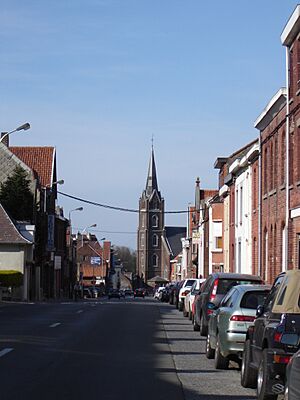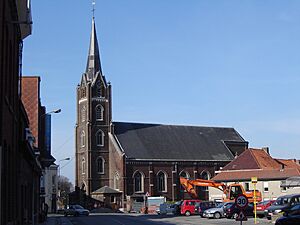Luingne facts for kids
Luingne is a small village in Wallonia, a region in Belgium. It is part of the larger town of Mouscron. Luingne is located in the province of Hainaut. People who live in Luingne are sometimes called "Cleugnottes."
Before 1977, Luingne was its own separate town. But then, many towns in Belgium joined together. This was called the fusion of municipalities. After this, Luingne became a district of Mouscron. The area of Luingne is about 554 acres.
Contents
Luingne's Church History
The church in Luingne has always stood in the same spot. It might even have been built on top of a much older church. Some drawings from 1813 show what an old church building might have looked like.
Challenges to the Church
The church faced some tough times in history. In 1566, there was a time when people damaged religious statues and art. This was called iconoclasm. The church in Luingne was also affected by this. Later, in 1676, during the wars of Louis XIV, the church needed repairs.
During the French Revolution in 1794, the church was again damaged. Things like valuable items were stolen by people called sans-culottes. A plan was made to replace these items.
Building a New Church
Between 1848 and 1850, a big decision was made. The old church was too small and not very stable. So, it was decided to take it down. A brand new church was built in its place. This new church was named Saint-Amand. It was built in a style called neo-gothic.
The new church cost 40,129 Belgian francs to build. It is 20 meters long and 18 meters wide. The church is 15 meters tall. Its clock-tower reaches high into the sky, at 42.80 meters.
Church Administration Through Time
The way churches are organized has changed a lot over the centuries. This section explains how Luingne's church was managed.
Early Church Records
In 1117, an important document called a charter was signed. It mentioned Ernulfus de Luina, who was connected to Luingne. Later, a Pope named Pascal II (who was Pope from 1090 to 1118) wrote a special letter called a papal bull. This letter mentioned the altar in Luingne. Another Pope, Clement III, also wrote a bull. It confirmed that the church and its land were given to the chapter of Tournai.
Changes in Church Districts
In 1146, the diocese of Tournai became separate from the diocese of Noyon. A diocese is like a large church district led by a bishop. Luingne's church then became part of a smaller area called the deanery of Helchin. A deanery is a group of churches.
In 1569, the bishop divided this deanery into two parts: Helchin-Flamand and Helchin-Wallon. Luingne was part of Helchin-Wallon.
Modern Church Organization
In 1801, a big change happened when Napoleon created the diocese of Ghent. Luingne, along with Mouscron and Herseaux, became part of the deanery of Menin.
Later, in 1932, a bishop named Monsignor Lamiroy created a new deanery. This one was for French-speaking churches within his Flemish diocese. It included Mouscron-Comines and the surrounding areas. Finally, in 1967, this deanery joined the diocese of Tournai under Monsignor Himmer.



